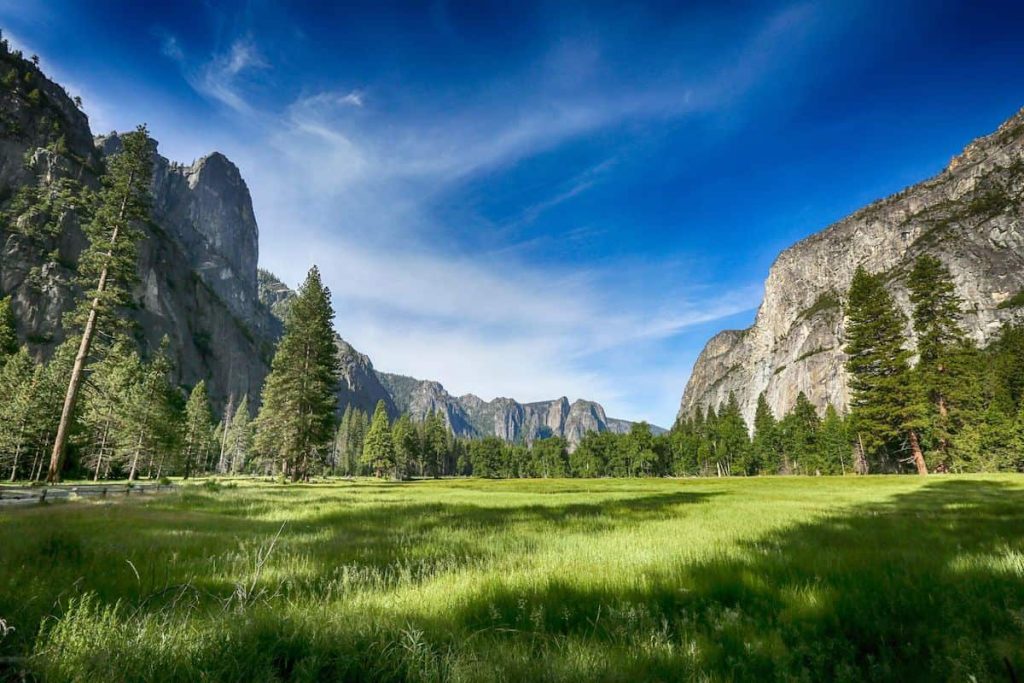
Best Backpacking Trails in Yosemite National Park photo by Mick Haupt
Are you looking for the best backpacking trails in Yosemite National Park? The park is recognized as one of the United States’ most iconic national parks, and an outdoor enthusiast’s paradise.
This guide provides a list of the best Yosemite backpacking trails, in addition to information on activities, wilderness permits, campground reservations, and other must-see attractions. From Grand Canyon of Tuolumne River to Tenaya Lake, this article will help you plan your dream backpacking adventure to Yosemite National Park.
Key Takeaways
- Yosemite National Park offers 800 miles of breathtaking trails, awe-inspiring natural landscapes and abundant wildlife.
- There are activities for visitors of all seasons from wildflowers & waterfalls during the spring months to outdoor recreation in summer,fall foliage in autumn & skiing/snowshoeing in winter.
- Permits and reservations must be obtained ahead of time when visiting Yosemite National Park – particularly for backpacking.
- It is important to research safety tips, recommended gear and wilderness permit guidelines prior to embarking on a backpacking trip through this extraordinary park.
The Best Yosemite Backpacking Trails
From the Half Dome to Clouds Rest, Yosemite Valley is home to some of the best backpacking trails in the country. Fans of multi-day hikes can explore memorable outdoor experiences at Tuolumne Meadows, The High Sierra Camps Loop or Tenaya Lake’s loop trail.
For those looking for something a little more engaging, there are thrilling routes like Grand Canyon of the Tuolumne River and Northern Yosemite Exploration.
Northern Yosemite
Nestled between Hetch Hetchy Reservoir and Yosemite Valley, Northern Yosemite offers a magnificent array of spectacular backpacking trails for visitors to explore. Enjoy the solitude of nature while taking in pristine beauty like Tenaya Lake, the Clark Range, and Tuolumne Meadows.
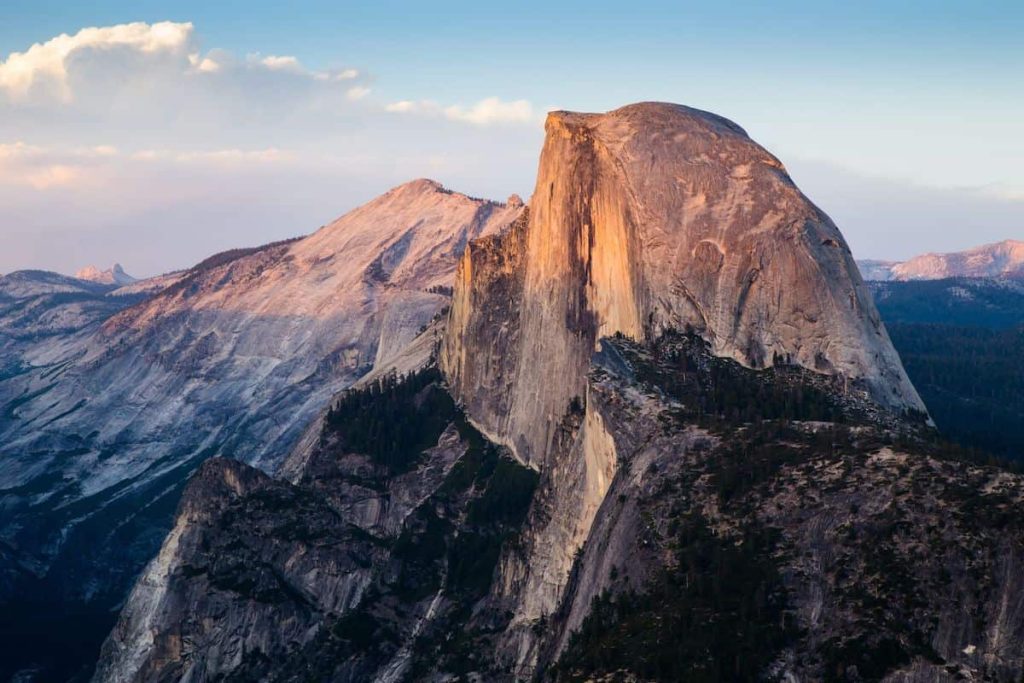
Half Dome photo by Yang Song
Yosemite Valley to Half Dome, Clouds Rest, and Sentinel Rock
The hike from Yosemite Valley to Half Dome, Clouds Rest, and Sentinel is a challenge that is well worth it. This 14 to 16-mile journey offers some of the most spectacular views in the park and creates an unforgettable experience.
Trek through rocky terrain up to the summit of Half Dome, or climb 9500 feet up Clouds Rest for an unforgettable view of Yosemite Valley. Take in breathtaking sunrises at the top of Sentinel Rock or take a leisurely stroll around Mirror Lake.
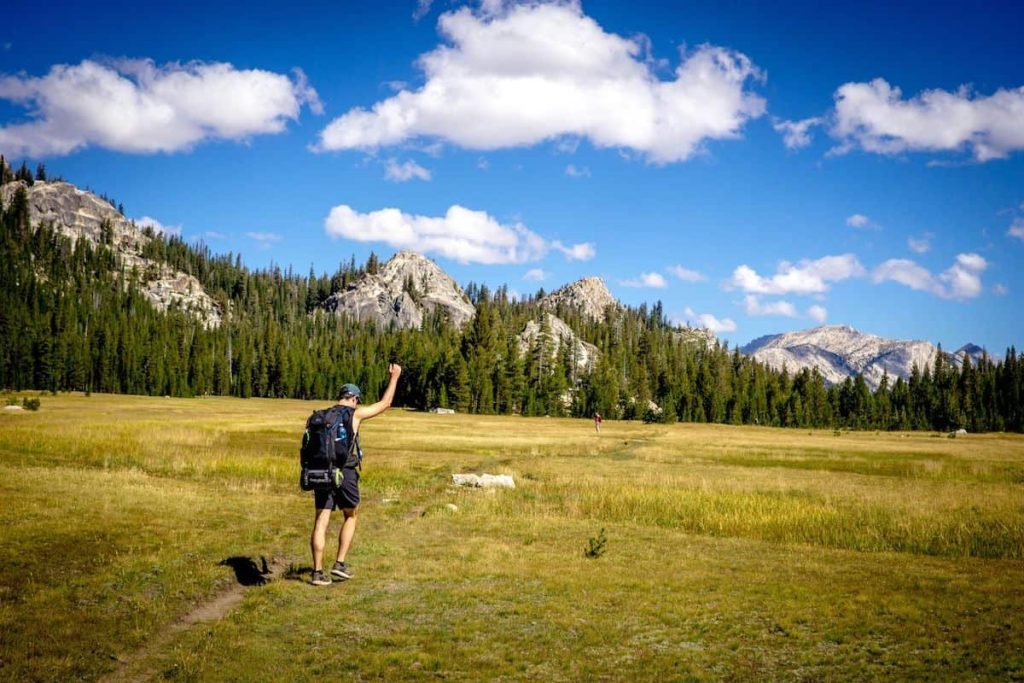
Tuolumne Meadows photo by Aaron Thomas
Tuolumne Meadows to Tenaya Lake
This 30-mile route is ideal for experienced backpackers due to its remote location and high elevation, which makes it both physically demanding and rewarding. The Tuolumne Meadows to Tenaya Lake trail starts at Lyell Canyon and passes through Ireland Creek, ascending to reach Ireland and Evelyn Lakes.
Travel through meadows lined with conifer trees as Tuolumne River winds downstream before reaching picturesque alpine lake Tenaya at an elevation of 8,150 feet above sea level.
It takes approximately 4 hours 52 minutes to complete this hike, offering climbers stunning views of Clouds Rest on their route to summit Half Dome Trail. Adventurers can also explore John Muir Trail into Yosemite Valley while discovering Glacier Point or Lower Yosemite Falls.
A permit is required before setting off on a trip from Tuolumne Meadows as well as reserving lodging near South Fork of Tuolumne River Trailhead for those planning a longer stay in the park.
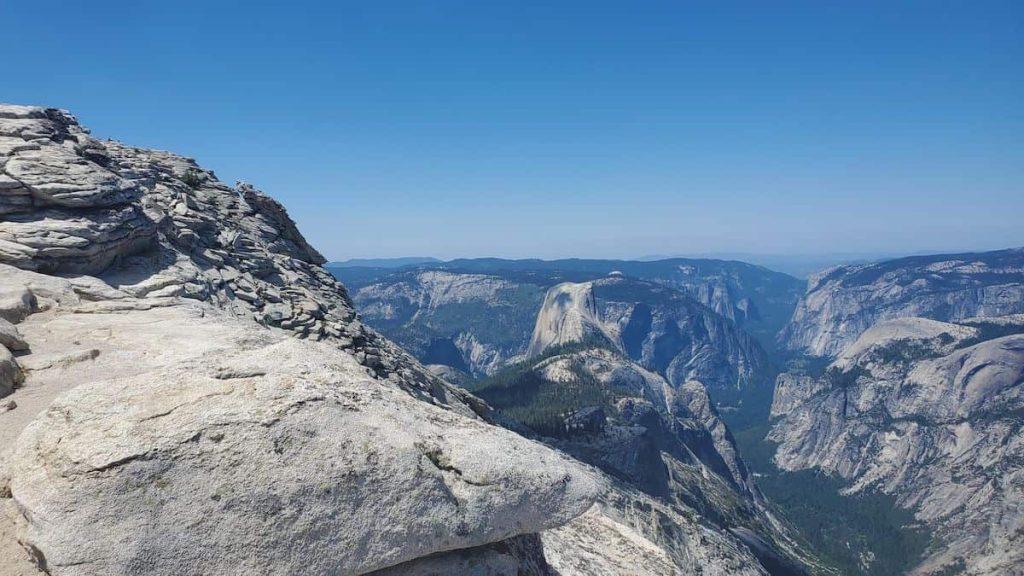
Cloud’s Rest photo by Tim Oldenkamp
The High Sierra Camps Loop
If you’re looking for a multi-day backpacking trip in Northern Yosemite with cozy stops along the way, this 44-mile loop is perfect! The High Sierra Camps Loop is located in Yosemite National Park’s Cathedral Range, with views of craggy granite and babbling streams.
It takes an average of 22 hours and 13 minutes to complete and is considered a challenging route that requires prior wilderness experience.
With plenty of access points along Tioga Road visitors can customize their trip by selecting several or all five camps that offer meals, hostel beds, showers, stores & ranger programs.
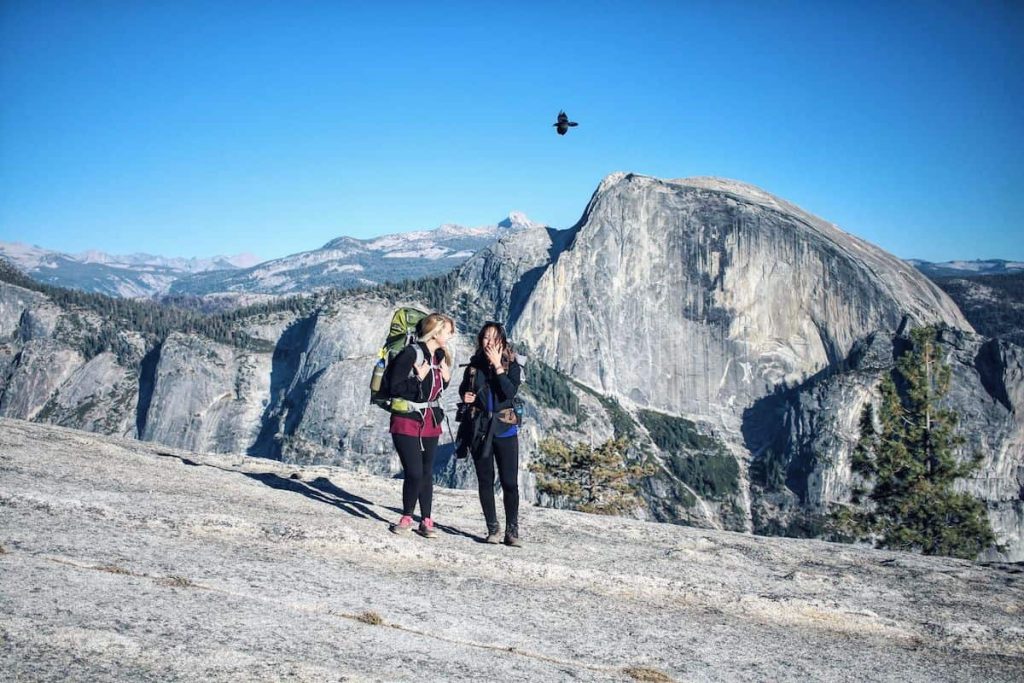
Yosemite Valley photo by Kelly Repreza
Yosemite Valley’s North Rim to Ten Lakes Basin
The Yosemite Valley’s North Rim to Ten Lakes Basin trail is a spectacular four-day, 45-mile backpacking loop featuring remarkable natural beauty and awe-inspiring views of Yosemite Valley. Along on this amazing adventure hikers can explore landmarks like North Dome, Yosemite Point, the top of Yosemite Falls, Eagle Peak, and El Capitan.

Cathedral Lake photo by Dylan Taylor
The Clark Range and Southeast Yosemite
For those seeking true solitude look no further than this 31 mile path starting off from Cathedral Lake Trailhead into majestic mountains, followed by great views descending the south side of Half Dome! Recharge your batteries among alluring alpine lakes scattered about throughout the area, in spots like Columbine Lake and the Merced River canyon!
The Clark Range and Southeast Yosemite mini-mountain range branches off from the main Sierra Nevada range at around 8,300 feet of elevation. The regions offer some of the best backpacking opportunities in California, showcasing rugged terrain, waterfalls, crisp lakes with abundant wildlife and flora all around.
The Grand Canyon of the Tuolumne River
As often referred as “the Grand Canyon” famous amongst adventurers around the world, this 10 mile stretch follows sweeping river bends downstream, and eventually leads back upstream to the starting trailhead.
The Grand Canyon of the Tuolumne River is known for its stunning beauty and remote location. It covers an impressive 33 miles of terrain and is considered one of Yosemite’s greatest highlights. Hikers will experience breathtaking mountain views as they traverse the canyon alongside the crystal-clear Tuolumne Wild & Scenic River.
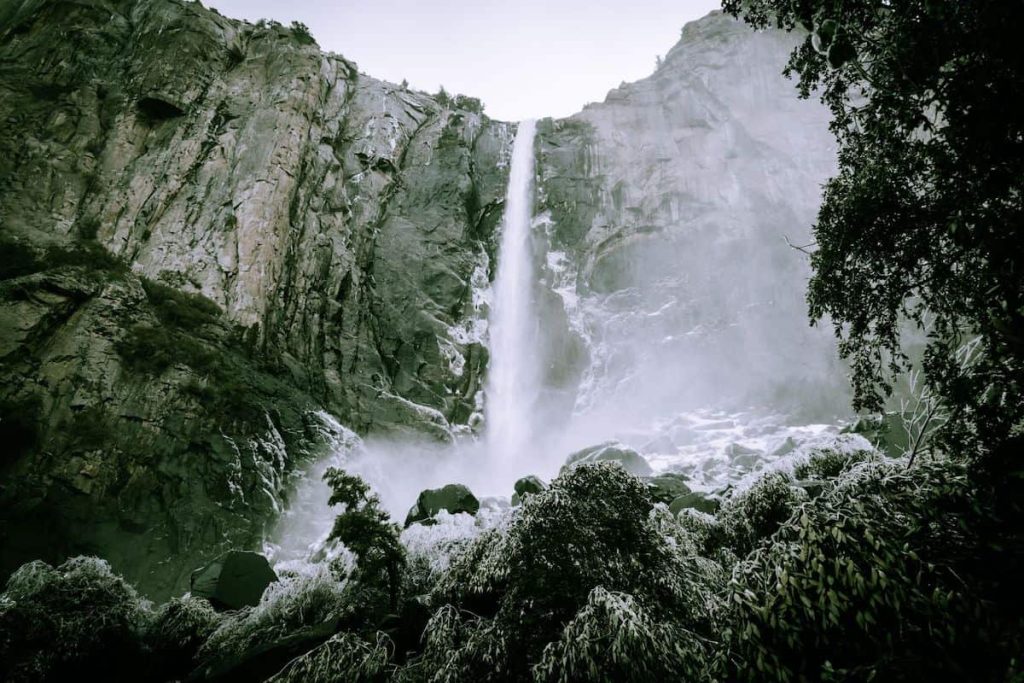
Bridalveil Fall, Yosemite photo by Hari Nandakumar
Yosemite Valley’s North Rim
Yosemite Valley’s North Rim is an off-the-beaten path adventure that takes you through some of the most spectacular landscapes and views in California. The North Rim trail takes hikers to North Dome, Yosemite Point, the top of Yosemite Falls, Eagle Peak, and El Capitan – the world’s largest single-chunk of granite.
There are several backpacking trips for those wanting to explore this remarkable area, including:
- The Full North Rim Trail: This is a popular choice for backpacking, camping and hiking. It is a 4-day roundtrip hike that passes through El Capitan Meadow with stunning views of Half Dome, Yosemite Valley’s Tenaya Creek canyon walls, Lembert Dome Summit & Glacier Point.
- High Sierra Camps Loop: Start from Tuolumne Meadows on this 5-day loop that will take you to May Lake High Sierra Camp before traversing a number of beautiful trails past meadows and waterfalls.
- Young Lakes/Mount Conness: On this 3-day backpack you’ll pass through pine forests as well as high alpine meadows to reach 12 scenic lakes that sit below Mount Conness.
- Yosemite Valley’s North Rim Trip: This 2-5 day adventure takes you up Canyon Mountain with its incredible vistas across Tenaya Canyon before crossing onto near vertical cliffs overlooking Turner Meadow and Mono Pass.
- Tioga Road Trails: Go east along Tioga Road on this 2 or 3 day trip with plenty of terrain variation for those looking for an easier yet no less stunning backpacking experience.
- Ten Lakes Basin: Explore wildflower filled meadows on this 13 ½ mile route that takes trekkers through peaceful forests before lining up north rim views from Indian Ridge Trail Junction towards Mono Creek Upper Falls lookout point. Once arriving at Ten Lakes Basin be sure you have enough time set aside as there are endless possibilities for outdoor activities such as fishing, swimming & rock climbing!
Where to Stay
Yosemite National Park’s camping facilities range from primitive tent campsites to RV sites with full hookups, allowing all visitors access to experience the park’s stunning beauty.
Upper Pines Campground
Upper Pines Campground in Yosemite National Park is the largest of three reservation campgrounds located in the valley. Located at an elevation of 4,000 feet (1,219 m), it offers breathtaking views and a quiet respite from life’s hustle and bustle.
Visitors have several options for camping, from tent-only sites to sites allowing vehicles for towing—imagine setting up your RV or trailer with beautiful views of El Capitan. Each campsite comes equipped with a picnic table, fire ring and food storage locker —perfect for cooking smores over an open flame! Upper Pines is also conveniently located near Yosemite attractions such as Glacier Point Road and hiking trails like Four Mile Trail that will give you panoramic views unlike ones elsewhere.
With so many options within walking distance, it’s no wonder this landmark destination draws visitors back year after year!
Camp 4
Located in Yosemite Valley, Camp 4 is one of the most popular camping spots for visitors to Yosemite National Park. With a significant historical background, the campground has been known for its well-preserved beauty and draws people from all over who are looking to experience it.
Moreover, due to its popularity, the campground operates on a first-come, first-served basis meaning that campers must arrive early in order to secure a spot. Additionally, there is also an available map of the area which visitors can use when planning their stay as well as reviews from previous visitors providing insights regarding what they can expect during their time at Camp 4.
As such this truly provides everyone with an amazing opportunity to explore one of nature’s greatest wonders!
Hotels and lodges
- Upper Pines Campground: This campsite is for those seeking an immersive outdoor experience. Located in Yosemite Valley, this campground offers both tent and RV camping options.
- Camp 4: Another camping option located in the heart of Yosemite Valley, Camp 4 provides varied terrain for exploration and activities. It features a variety of sites with views of El Capitan and Half Dome.
- Hotels and lodges: Located near the five entrances of Yosemite National Park, there are numerous hotels and lodges to choose from featuring unique amenities like pools, spas, fireplaces, game rooms and more. Rush Creek Lodge is a popular choice for travelers due to its scenic setting on the Hetch Hetchy Reservoir with a range of activities nearby such as biking, kayaking and horseback riding. Yosemite Valley Lodge offers luxury accommodations with an onsite restaurant, bar, heated pool, store and more.
What to Do in Yosemite National Park
From an invigorating day hike to a leisurely swim, Yosemite National Park is the ultimate destination for all outdoor enthusiasts looking for adventure.
Backpacking
Yosemite National Park boasts some of the most spectacular backpacking routes in world, all ensconced in natural beauty. From the Yosemite Valley to Half Dome, Clouds Rest and Sunrise, up to Tuolumne Meadows and Tenaya Lake, and through High Sierra Camps Loop or along one of the five popular trails around the park – there’s something for everyone who loves wilderness exploration.
If you’re keen on trekking over mountainous terrain and enjoying a range of breathtaking views across valleys carved by cascading waterfalls then Yosemite has it all! Whether it’s snowshoeing or skiing during winter months; hiking during summer; wildflower viewing in the springtime; solitude amidst fall foliage; stunning lakeside camping experiences at any time of year – getting outdoors here is unforgettable.
All hikers need to obtain a wilderness permit before begin their journey into nature, so consider planning your trip ahead and making reservations early.
Day hiking
Yosemite National Park is one of the best places to go for an unforgettable outdoor experience. One of its most popular activities is day hiking, and with good reason – it provides a great way to explore the park’s natural wonders without needing any special equipment or skills.
Day hikes offer visitors a variety of routes and terrains from which to choose, ranging from easier trails like Lower Yosemite Falls trail in Yosemite Valley that are perfect for families, to more challenging ones such as Half Dome Trail, where experienced hikers can test their mettle against steep inclines.
Some other popular attractions include Glacier Point – offering stunning vista points along its 1-mile short outing route -and Tenaya Lake – granting explorers access into incredible alpine lakeside grounds via meadows full too brim with wildflower blooms come springtime.
Biking
Yosemite National Park offers world-class opportunities for visitors to explore the park’s foothills and National Forest lands through biking. Biking is a great way to get out into nature, take in stunning views, explore more distant trailheads than hiking could allow, and enjoy fresh air while also getting exercise.
Bike rentals are available in Yosemite Valley making it easy for travelers who don’t have their own bikes or who aren’t flying with them — riders can find road bikes (available by half day or full day rental) plus electric bike options as well.
Mountain biking trails nearby offer an inclusive experience that shouldn’t be missed — enjoying the grandeur of towering sequoias and evergreen pines from both high mountain viewpoint vistas as well as down on the forest floor where climbers might cross knee deep creeks all while exploring some of the most breathtaking granite cliffs found anywhere on earth can make for a truly thrilling adventure! In 2023, Yosemite will feature ‘Bike Only Days’ offering exclusive access to bikers looking to fully immerse themselves in this beautiful landscape without any distractions other than wildflower fields bursting buds! So why wait? Put touring around Yosemite atop your list of must do activities and come experience this one of a kind destination first hand!
Swimming
Yosemite National Park offers a range of swimming opportunities. From lakes and rivers to family-friendly pools, there are plenty of ways to cool off in the stunning natural environment.
In summer months, activities such as rafting, fishing, swimming and boating are popular with visitors looking for outdoor fun. It’s important to exercise caution when swimming in creeks and rivers, as the water can be powerful at times.
Visitors should never swim or wade upstream from the brink of a waterfall – even if it appears shallow – as this is extremely dangerous. Certain areas such as Emerald Pool and the Silver Apron are forbidden for safety reasons so follow any signage closely.
Additionally there may be hidden swimming holes located around Yosemite that only knowledgeable locals know about! Popular spots include Tenaya Lake – known for its beautiful views – but visitors should bear in mind that Yosemite Falls is not suitable for swimming due to sudden current changes near drop-offs beneath the falls surface.
Climbing
Yosemite National Park is renowned as one of the world’s greatest climbing areas, offering a diverse range of challenges for climbers. Its granite crags and rock formations make it an ideal location for climbing, boasting thousands of routes suitable for those with varying degrees of experience – so whether you’re just starting out or ready to tackle El Capitan, Yosemite has something to offer everyone who wants to explore the art of scaling rocks.
To ensure safety during your climb in Yosemite, always remember to check weather conditions, use proper equipment and attire at all times, obtain necessary permits if required and be aware of other outdoor activities such as hiking which can have impacts on your experience.
With its inspiring natural beauty that often leaves exhilarated climbers speechless and breath-taking views seen from its spectacular granite walls upon summiting – Yosemite’s rocky paradise promises thrilling rewards like no other!
When to Visit
No matter the time of year, Yosemite National Park has something to offer for all kinds of visitors; from wildflowers and waterfalls during springtime, to endless outdoor activities in the summer months, stunning fall foliage in late autumn, and winter adventures like skiing and snowshoeing.
https://www.youtube.com/watch?v=tmxYGJCvniw
Spring: Wildflowers and waterfalls
Yosemite National Park is transformed into something magical in the spring, as wildflowers come alive to paint the park’s meadows and hills with vibrant colors, while powerful waterfalls explode over its granite cliffs.
Spring is the perfect time to explore Yosemite’s majestic beauty, witnessing incredible cascades like Yosemite Falls at peak flow and colorful meadows of daisies, poppies, lilies, columbines and more.
On any outdoor adventure you may see rare wildlife such as pine marten or bobcat amongst lush forests that are teeming with life. So why not plan that dream trip this season – seize the opportunity to experience everything nature has to offer!
Summer: Hiking and camping
Yosemite National Park is a prime destination to experience California’s most stunning natural beauty. With rolling meadows of wildflowers, glistening lakes, dramatic valleys and waterfalls, and some of the best hiking trails in the United States – it’s no wonder that Yosemite is a top destination for outdoor enthusiasts during summers.
The park has something for everyone – from moderate day hikes suitable for beginners to more challenging multi-day backpacking trips through remote peaks and high-altitude trails.
Some popular routes include Mirror Lake Loop Trail, Yosemite Falls Trail; Half Dome Trail (which must be hiked with a permit), Cloud Rest Summit Trail, Four Mile Trail which takes you up to Glacier Point, Snow Creek Falls Hike (best experienced early summer before the snow melts) , Gaylor Lakes Basin Hike, John Muir Wilderness Iconic Overnighters , Mist trail hike along Vernal & Nevada Fall The High Sierra Camps loop or the Grand Canyon of Tuolumne River which starts at White Wolf near Tioga Pass road gate.
Each route offers its own unique view of Yosemite’s spectacular natural beauty while providing hikers opportunities to explore diverse wildlife and lush green meadows around every turn.
Fall: Fall foliage and fewer crowds
Yosemite National Park in the fall is truly an experience like no other. Visitors can witness vibrant colors of big-leaf maples and black oaks, as well as enjoy cooler temperatures, milder conditions and far fewer crowds compared to the summer months.
The Tioga Pass provides stunning scenic views amid the colorful foliage during this season, resulting in fantastic photography opportunities that could otherwise be missed during peak visitation times.
Backpacking enthusiasts will find great value with accommodations and activities being less expensive than usual; for even greater savings some roads which are closed during winter may still be open offering unfettered access.
Winter: Snowshoeing and skiing
Yosemite National Park is a great destination for winter activities such as snowshoeing and skiing. Hiking, snowshoeing, and cross-country skiing are popular choices to explore the Yosemite Valley during winter months.
At higher elevations (from December to March) you can find prime conditions for winter sports like skiing and snowshoeing. Storms in the park make it an ideal choice for Nordic skiers looking for fresh powder conditions.
For those who want equipment rentals or ski lessons, Badger Pass Ski Area offers both with a variety of trails available including some perfect for beginners and novice skiers alike! The vast wilderness of Northern Yosemite also provides excellent opportunities to trek in snowy terrain while taking in picturesque views of mountains blanketed with white frost.
Know Before You Go: Permitting and Reservations
It is important to understand the wilderness permit system and reserve campsites or accommodations in advance before embarking on a backpacking experience in Yosemite National Park.
https://www.youtube.com/watch?v=dqMmziKT6uA
Understanding the wilderness permit system
In Yosemite National Park, visitors are required to obtain a permit for any activity on its undeveloped lands such as backpacking or day hiking. The wilderness permit system is an important regulation measure that helps manage the park’s natural resources while maintaining safe access and maximum enjoyment of the environment.
Obtaining the right permits can greatly enhance your outdoor experience in Yosemite National Park. To begin with, visitors need to understand the permitting process and requirements in order to get started.
All camping activities require a Wilderness Permit which can be obtained from ranger stations, visitor centers, or online. It is best to plan ahead and make advanced reservations for permits before arriving at the park.
For peak times such as spring break season, popular trailheads like Half Dome and Clouds Rest also have lottery systems that decide who gets access dates for their outings well ahead of time.
Reserving campsites and accommodations
When visiting Yosemite National Park, reservations are extremely important for both camping and accommodations. Reservations for campgrounds in the park ranges from April to October and require advanced booking if you want to ensure a place.
Making sure you have plans in advance can help your trip go more smoothly since same day reservations aren’t available at most of the parks 13 popular campsites. Additionally, certain wilderness permits can be required for all overnight stays within the park – so it’s wise to look into that before hitting go on booking anything.
It is also advised to reserve your accommodation early as popular lodges tend to fill up well ahead of time! With COVID-19 hanging around worldwide, there may be changes upcoming; however, as of now reservation requirements remain the same until October 2021 at least.
Conclusion
The Ultimate Guide To The Best Backpacking Trails In Yosemite National Park is truly a comprehensive and invaluable resource for adventurers looking to explore the park’s natural beauty.
This guide provides backpackers with essential information on the best trails in Yosemite, suitable for all abilities from beginner to seasoned explorer. From Half Dome peak, Tuolumne Meadows and Sunrise Lake to Tenaya Lake, Glacier Point viewpoint and Valley Floor Loop – or customizing a unique itinerary based on dedication time- frame – this guide helps travelers find their perfect trail as they discover breathtaking waterfalls, enjoy exciting outdoor activities and immerse themselves in nature’s wonders.
With its extensive knowledge of backpacking routes, camping sites considerations, safety tips and gear advice – this ultimate guide is an absolute must if you want to enjoy your trip through one of America’s most beautiful parks.
Related Posts:






